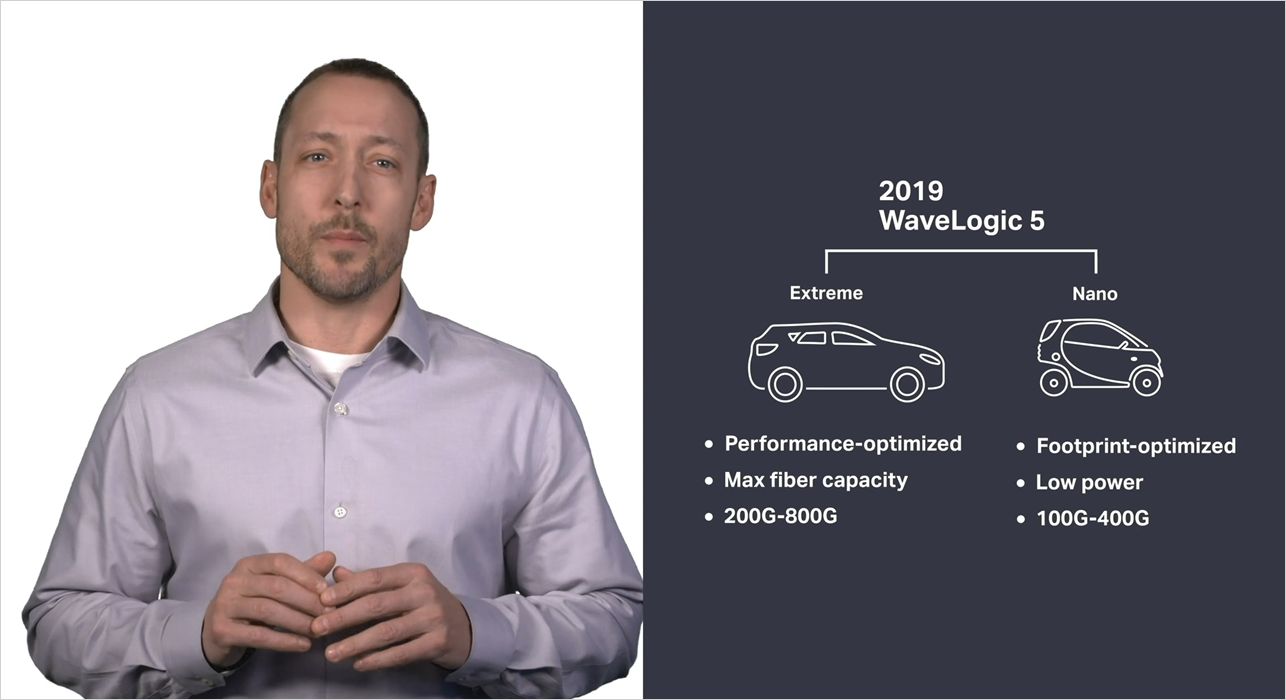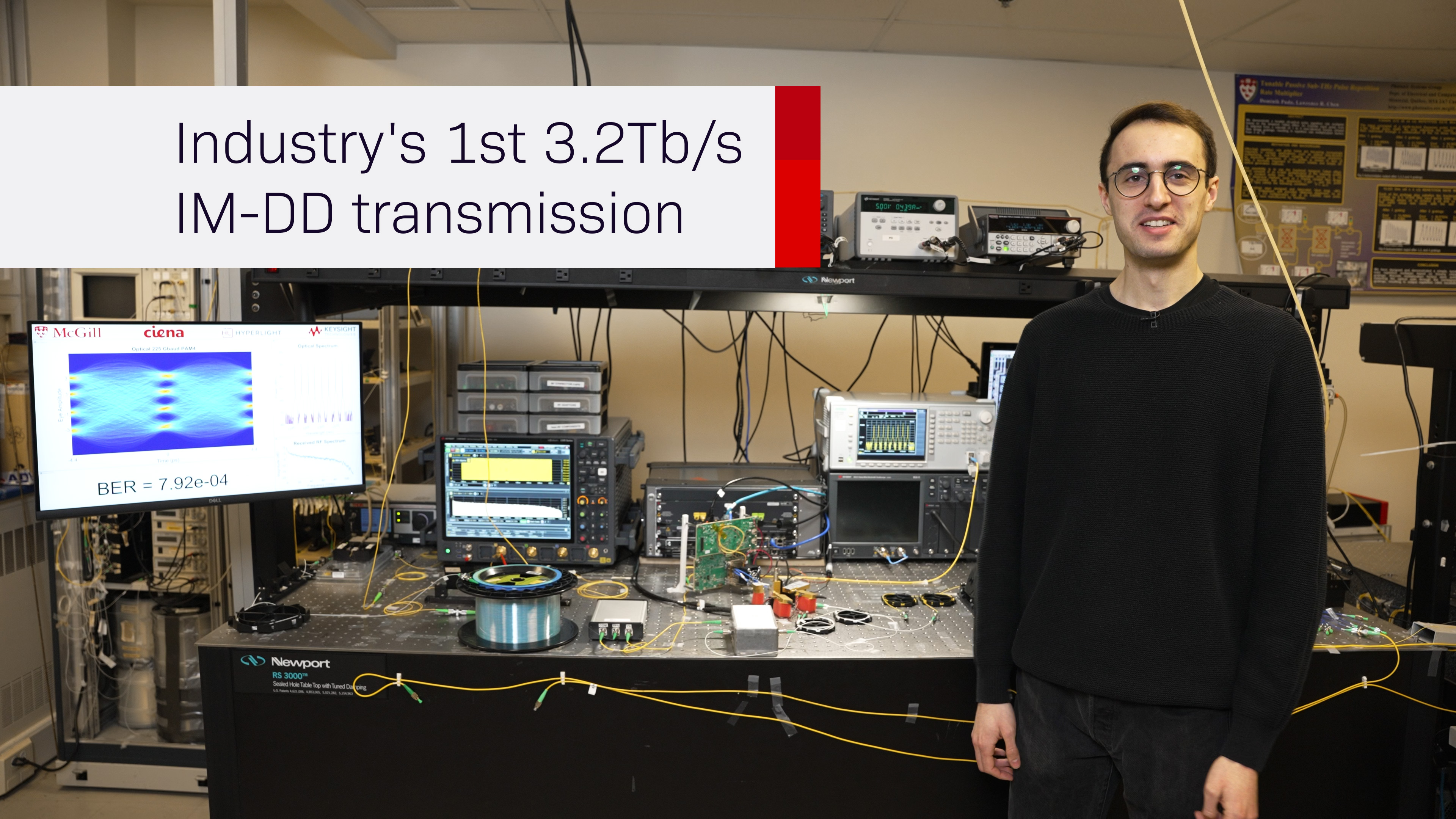What is ZR+?
Global optical networks continue to evolve, necessitating new and innovative solutions to meet the requirements of network operators to maximize fiber utilization and reduce the cost of data transport. Coherent optical transmission has been the key technology supporting both requirements over the last decade— and this will continue for the next stages of network evolution.
In early 2020, 800G-capable performance-optimized transport systems were introduced and have since been deployed around the world allowing customers to benefit from new network efficiencies and cost savings from this latest generation of coherent technology. What’s next?
In 2021, coherent pluggables supporting data rates from 100G to 400G and optimized for low power and small space requirements for high-density modular systems will start to be deployed in networks. This latest generation of products extend the economic benefits of coherent innovation into new application areas.
400ZR is an example of one of the first 400G solutions in this new class of pluggable coherent products to hit the market and will initially be used by hyperscale data center operators for single-span connectivity between data centers. Implemented predominantly in QSFP-DD form factors, 400ZR will serve the specific requirement for large-scale switch fabric extension by plugging directly into router faceplates for massive parallel data center interconnect of 400GbE for distances of 80 - 120km.
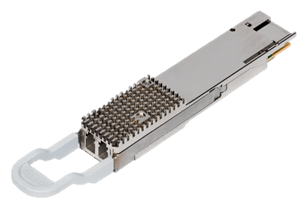
Figure 1. WaveLogic 5 Nano 400ZR QSFP-DD transceiver
Pluggable innovation isn’t stopping there though. Beyond 400ZR, referred to as “ZR+”, are a range of coherent pluggable solutions—with line capacities up to 400 Gb/s and reaches well beyond the 80km specification for 400ZR that will support a number of application requirements. Next-generation metro-regional networks will take advantage of advances made with these low-power pluggable coherent solutions in multi-port hardware interfaces where required. In these metro networks, modularity will be further enhanced by supporting multiple different channel capacities depending upon the reach requirements and compatibility with the installed metro optical infrastructure.
ZR+ definitions
The specific operational and performance requirements of different applications will determine what types of ZR+ coherent plugs will be used in networks. Some applications will take advantage of interoperable, multi-vendor ecosystems defined by standards body or MSA specifications and others will rely on the maximum performance achievable in the constraints of a pluggable module package. Different categories of ZR+ applications are explained below.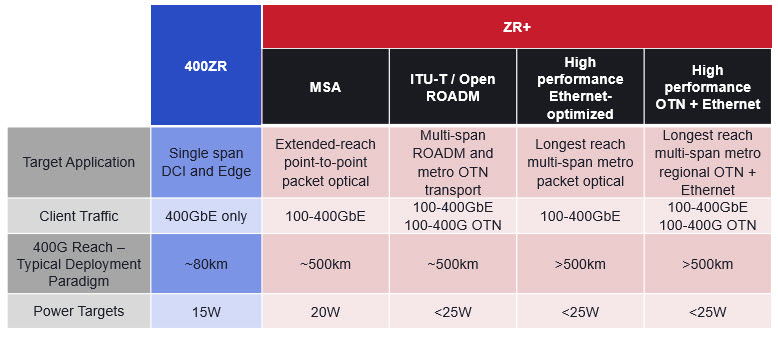
Figure 2. 400ZR and 400ZR+ categories
Extended reach 400ZR: One definition of ZR+ is a straightforward extension of 400ZR transcoded mappings of Ethernet with a higher performance FEC than 400ZR CFEC to support longer reaches. In this case, ZR+ modules are narrowly defined as supporting a single-carrier 400 Gb/s optical line rate and transporting 400GbE, 2 x 200GbE or 4x100GbE client signals for point-to-point reaches (up to around 500km). Based on the framing and mapping protocols supported, these solutions are specifically dedicated to packet transport applications and destined for router platforms. The OpenZR+ MSA has published a specification to cover this specific application.
Standards-based metro ROADM: Another definition is the inclusion of support for OTN, for example client mapping and multiplexing into FlexO interfaces. These coherent pluggable solutions are intended to support the additional requirements of OTN networks, carry both Ethernet and OTN clients, address transport in multi-span ROADM networks, can operationalize OTN regens, can support multi-lambda bonding applications, are required where demarcation is important to operators, and are destined primarily for optical transport platforms. The ITU-T and Open ROADM MSA are addressing these application requirements.
High performance, Ethernet-optimized: A third definition is support for extended reach Ethernet – or packet – transcoded solutions that are further optimized for critical performance metrics such as latency, throughput and timing. These coherent pluggables leverage high performance FEC and sophisticated coding algorithms with Probabilistic Constellation Shaping (PCS), to support metro-regional reaches in DWDM deployments that are typically outside the ranges developed in standards and MSAs.
High performance, OTN + Ethernet: Finally, a fourth definition entails support for extended reaches such as in multi-hop, metro-regional ROADM networks with OTN support. These coherent pluggables also leverage high performance FEC and PCS, along with tunable optical filters and amplifiers for maximum reach. They support both Ethernet and OTN clients and a rich feature set of OTN network functions for deployment over both fixed and flex-grid line systems. Such modules extend capabilities well beyond the scope of Open ROADM and ITU “Black Link” applications, for example, but allow support for bookended solutions with higher performance to address a much wider range of metro networking requirements. In turn, the standards provide a baseline means to manage and model these performance modes in a functionally standard way.
There is a broad range of coverage for ZR+ coherent pluggables, as shown below, and it is expected these products will be deployed across a range of products including switches, routers, and optical transport equipment. Customer operational requirements, network architecture, and traffic growth rates will dictate which product is used.
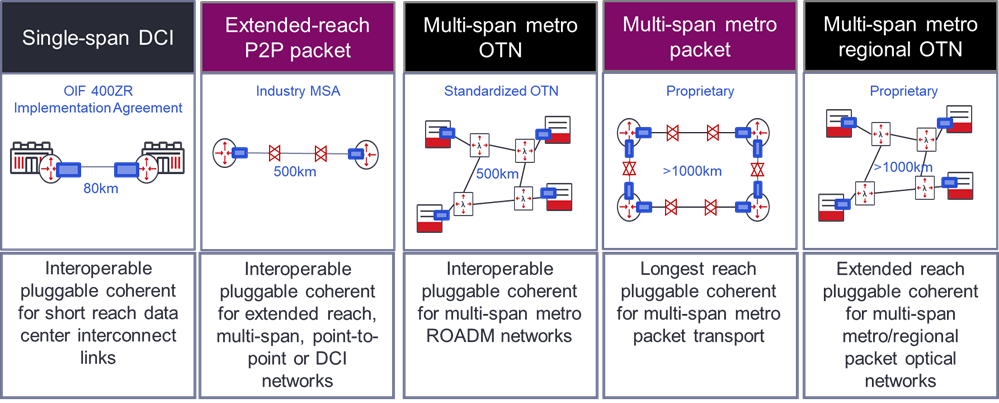
Figure 3. 400ZR and ZR+ applications
Attributes for coherent pluggable interoperability
The OIF 400ZR IA is an example of one of the first coherent pluggable interoperable 400G standards. It does not stipulate a specific form factor for implementations but does indicate the use of a low-power DSP and an intent to target pluggable digital coherent optics (DCOs) that support port densities similar to those used for grey client optics. This places constraints on the design and selection of 400ZR DSP, electro-optical, and peripheral components, but allows for support of the smallest possible form factors – such as QSFP-DD and OSFP – that are compatible with router interfaces which is a key requirement for the single-span DCI application. To address interoperability requirements, the 400ZR IA includes specifications such as the line signaling rate, modulation format, FEC code, protocol format and transmit and receive optical specifications.
As the industry moves towards real-world deployments of 400ZR, key operator requirements are being refined. Interoperability in a multi-vendor operational environment requires consistency and accuracy of Performance Monitoring (PM) statistics which are captured independently from different modems’ DSPs. For maximum fiber capacity, support for full-fill on a router interface with 400ZR plugs without any reach penalties incurred running over 75GHz fixed-grid line systems is required. The flexibility of adjustable transmit power allows for link optimization and stable performance over the lifetime of the deployment. Finally, for most efficient network level costs and efficiency, the power dissipation of the 400ZR coherent pluggables must support an optimum thermal profile in the router blade. In the ZR+ category of coherent pluggable solutions, there are a number of industry standard and MSA-based specifications defined for interoperable implementations.
Early steps for interoperable ZR+
The ITU-T Study Group 15 has been working on FlexO standards for extended reach transport based on a metro and metro-edge ‘black link’ definition for 100G – 400G transport. This standard covers the use of interoperable coherent interfaces in OTN networks. MSA-based industry specifications have also solidified over the last year. Similar to 400ZR, they are not prescriptive about the form factor package to be used but rather on the client mapping, framing, symbol mapping, FEC algorithm and transmit and receive optical performance characteristics for the target applications.
Target form factors for these MSA specifications include WAN-optimized plug form factors - like CFP2-DCO with its larger size and higher power envelope allowing more functionality and scope for integrated amplifiers and tunable filters – and client-like form factors – like QSFP-DD and OSFP- optimized for highest density and lowest power. The application, host platform port requirement, as well as the power dissipation of the individual implementation, will dictate which form factor is used.
The OpenZR+ specification defines 100G – 400G single-wavelength optical ports dedicated to the transport of Ethernet clients. The DSP framing format is based on OIF 400ZR framing adapted for a different FEC – called open forward error correction (or OFEC). Optical specifications are predominantly amenable to colored applications for extended-reach DCI.
The Open ROADM MSA Single-Wave (or W) optical specification is aimed at interoperable interfaces typically enabled by pluggable optics used in disaggregated ROADM networks. As such, there are key definitions for the optical transmit and receive design specifications of these plugs so they can support functions like colorless add/drop. Some of these are highlighted as a qualitative comparison to the OpenZR+ MSA specification in the table below.

Figure 5: Comparison of Open ROADM and OpenZR+ characteristics
The OpenZR+ specification was not designed for metro ROADM architectures so applicability would be limited in these networks.
Maximum performance for ZR+
400ZR performance, while not comparable to the capacity and reach of coherent solutions for long-haul terrestrial and submarine networks, is still a leap forward in the application of coherent technology. It requires skill sets in foundational technologies like digital and analog design in CMOS for the coherent DSP, and photonic integrated circuit design in silicon photonics for the optical front-end. These elements must be co-designed for optimal implementation.
ZR+ coherent pluggables take implementation challenges to the next level by adding some of the elements for high-performance solutions while pushing component design for low-power, pluggability, and modularity. Depending on the application requirements for reach, propagation in real metro networking scenarios, number of transmissions modes, and client interface support, this impacts power dissipation of the implementation, which impacts the choice of mechanical form factor. This combination of system and component design experience underpins Ciena’s WaveLogicTM 5 Nano portfolio of coherent pluggable products.
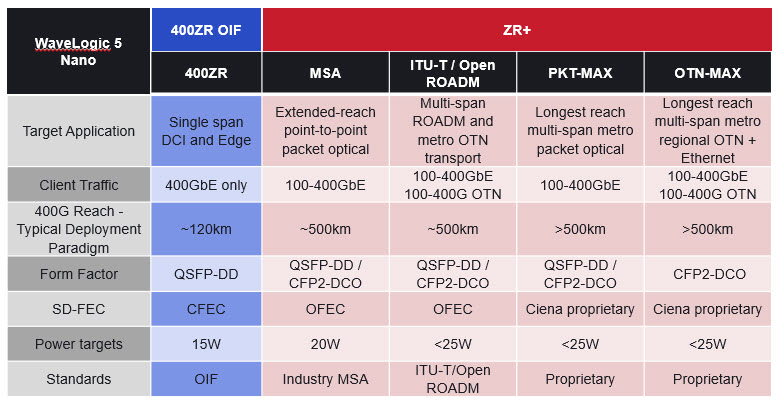
Figure 5: WaveLogic 5 Nano portfolio
WaveLogic 5 Nano
Ciena’s WaveLogic 5 Nano portfolio supports both interoperable standards and extended-reach high-performance modes driving the next generation of DCI and metro networks. For applications requiring the benefits of reduced power, highest port density, and multi-vendor interoperability, the WaveLogic 5 Nano standards-based modes are ideal. Where operators need to combine the density and modularity of pluggable coherent solutions together with support for broader feature sets and longer reach, the WaveLogic 5 Nano extended reach modes offer best-in-class pluggable performance. Available in compact form factors with optimized thermal budgets and taking advantage of higher symbol rates, Probabilistic Constellation Shaping (PCS) and advanced FEC, WaveLogic 5 Nano transceivers support the extended reach required for deployment in Metro-Regional multi-span networks.
Learn more about Ciena's WaveLogic 5 Nano and Optical Microsystems portfolios.

